 |
Articles
26 Nov 2010 The DASSAULT SYSTEMES Success StoryFrancis BERNARD DS Cofounder (1981), President (1981-1995), Member of the Board (1995-2006)
Editorial: Francis Bernard is also well known in Russia as the founder and first director of the office of Dassault Systems Russia. Francis have had a great personal influence on the dissemination of ideas of PLM in the Russian market. This professional and human influence was also implemented in Siberia where Francis actively participated in three isicad forums: 2004, 2006, and 2008.
This article is published with the kind permission of the author.
 During the past 50 years, starting in the 60’s, the world has dramatically changed. Hopefully it has been a long period of peace, following the first and the second world wars. And we have experienced two major evolutions:
During the past 50 years, starting in the 60’s, the world has dramatically changed. Hopefully it has been a long period of peace, following the first and the second world wars. And we have experienced two major evolutions:
-
the Information Technology (IT) revolution, an incredible change in our professional and private life with the computer, software and telecommunication technologies,
-
the Globalization, together with the end of the cold war in the late 80’s, gradually erased the borders, opening up market opportunities for alliances, and unbelievable cultural mixing.
I should add for myself, to this favorable environment, a third component. After my graduation from the French Aerospace University (Supaero), I started in 1967, as a young engineer, my professional life in one of the most innovative company in the world, Dassault Aviation. This was the right place to catch the benefits of the world evolutions.
And my professional life has been like a dream…It gave me the opportunity to become the “father” of one of the most famous software product in the world, CATIA, and the founder of one of the greatest success story of the last 30 years in the software industry : the Dassault Systèmes company.
I am going to outline this story…
DASSAULT AVIATION
The right place to be within the Dassault Aviation Company, when you are an ambitious engineer in the 60’s, is the Design Office. This is where you learn how to design a new aircraft, using a pencil, a paper and a drawing board.
But I prefer to join a newly implemented department, called “Advanced Studies Division”. Here, the engineers optimize the performance of the airplane, through theoretical and experimental aerodynamics.
In such department, you must enjoy playing with sciences and mathematics.
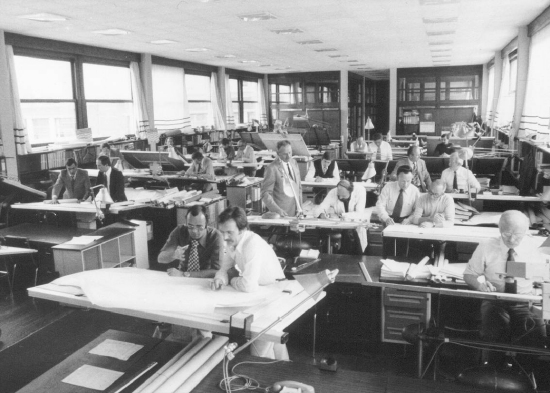 The Design Office in the 60’s
The Design Office in the 60’s
We design and build a new military airplane almost every year, for the air force: Mirage III, Mirage IV, Mirage V, Mirage G, Mirage F, Alpha Jet…We can see the change compared to nowadays. During the cold war, the threat from the east was strong enough to justify the launch of new airplanes, either for advanced demonstrators or for mass production, nearly every year. Nowadays, this short yearly time unit has been extended to decades and may become a half century! Also Dassault develops a new generation of advanced Business Jets: Falcon 10, Falcon 20 and a commercial mid-range, twin engines jet : Mercure. Such commercial jet has been the unique attempt of Dassault to enter the commercial market, now in the hands of Airbus. Nowadays, because of the decline of the military market, the main and very successful business of Dassault Aviation is with the Falcon products line.
An airplane must be optimized to fly securely as fast as possible, as far as possible, at the lowest possible cost, according to its mission. This means that we must be at the leading edge of technologies and innovation, to compute and optimize the behavior of the airplane. We are therefore the first enterprise in France to invest massively in computers and software in the early 60’s.We install in 1968 the two first interactive graphic terminals in Europe, called IBM 2250, connected to the first generation of the IBM mainframe computers.
But with the first computers, there is no software to run any application. It is only a huge hardware device with a basic operating system. We know how to manipulate mathematics, we know how to predict a theoretical aerodynamic flow with a set of equations, but we have only a rudimentary knowledge of software development. Therefore, we progressively learn how an aerodynamics specialist must become a software developer to resolve aerodynamics problems.
Then, we have another challenge: how can we define, with the computer, the shape of the airplane, which is the input to aerodynamics analysis? How can we define a curve, a surface, with mathematics and then with a software? This is where I find my mission: to invent the mathematical algorithms, and then to develop the computer programs to define, to manage, and to use complex shapes like the wing profiles and surfaces, the fuselage…all the skin of the airplane. This is the emergence of CAD (Computer Aided Design).
 Aerodynamics analysis
Aerodynamics analysis
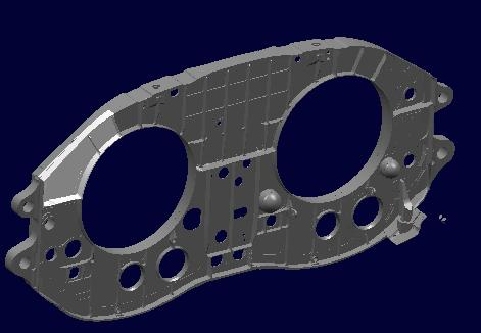 A solid structural part
A solid structural part
CAD, born from an aerodynamics requirement, becomes a mandatory tool within the company. In the early 70’s, I am heading a team to define numerically the shape of the airplane, for the aerodynamics specialists and the stress analysis specialists, and finally also for the Design Office. Here, it is an input from the 3D master geometry of the airplane to the 2D drawings defining all the details of the structure and components.
In the late 60’s, we install the first Numerical Control (NC) machines in the manufacturing plants. These machines are used to carve in thick solid aluminum blocks the most complex structural parts of the airplane. It is a requirement, particularly for the military aircrafts, to get the best performance with the lightest structure. From the CAD definition of the shape of a complex part, we develop a software to define the paths of the machine tool and then to download such information to drive the NC machine. This is the birth of Computer Aided Manufacturing (CAM).
The integration, on the same data base of CAD and CAM has been called CAD/CAM. For the first time in the industry, the exact same geometry data are used for Design, Analysis and Simulation, and Manufacturing, eliminating all the transcription and interpretation mistakes along the design and manufacturing processes.
In the early 70’s, the two first airplanes of which the skin and the main structural parts are designed, optimized and manufactured with our CAD/CAM solutions are the Alphajet (a military trainer) and the Mercure (a commercial airplane).
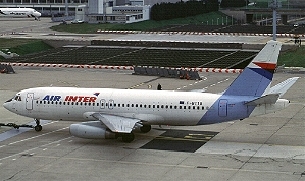 Mercure
Mercure
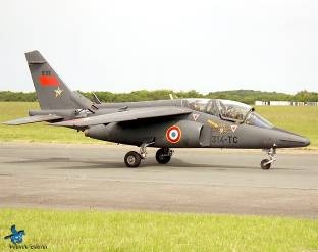 Alphajet
Alphajet
As a summary, from 1967 to 1977, one can understand how we took advantage of the technological innovations from computers, interactive graphic terminals and numerical control machines, within the extremely favorable environment of an innovative enterprise addressing a dynamic commercial and defense aircraft market. We initiated a new way to Design, Simulate and Manufacture. More generally, most of the aircraft industry took a leadership position in the CAD/CAM revolution, in the USA as well as in Europe. As a matter of fact, the mandatory requirement is to optimize the airplane through calculation, and to use the numerical control machines to carve the main structural components.
During this decade, I developed with my team a full set of 3D CAD/CAM applications and all our airplanes were progressively designed and built using these software. But it was a set of tools, developed step by step according to specific and urgent requirements, with a relatively low level of integration. Also, it was rather complicated to use the software. As a matter of fact, we were still dependent on punched cards and alphanumeric language for most of the applications, such as for instance intersecting two surfaces, because the computers and graphic terminals were too slow to allow an easy intuitive real time user interface. You had to be a specialist to use the software. Therefore we operated this way: my team developed the software, and used it upon request of the engineers of the other departments of the enterprise. For example, a designer of the Design Office would request a section of the wing by a given plane; my team would execute the job with our computer programs and deliver the requested section curve on paper, drawn by the computer on a drawing machine. In other words, the 3D CAD/CAM was not yet fully integrated and deployed within the internal working processes of the enterprise.
The only way to make a new step to reduce significantly the Design and Manufacturing cycle time was therefore to make it easy for the non-specialists of all the departments of the enterprise to use the 3D CAD/CAM software as their own tool. The top management was extremely eager, for instance, to reduce by a factor 4 the Design and Manufacturing cycle time of a new wind tunnel model of the aircraft. This would allow testing 4 variants of the same airplane, before launching the detail design of the best variant.
In 1977, with the full support of my management, I decide to launch the rewrite all our software, on a single architecture and with a full interactive graphic interface, in order to make it easy for non-specialists. The computer technologies had evolved considerably since ten years, and we have now more powerful mainframes and a new generation of graphic terminals (IBM3250). It is possible to compute and visualize 3D elements like surfaces in real time…despite we are still very far from the PCs of today. As a matter of fact the computation time may be quite long if there are too many active users connected to the same mainframe and the graphic terminals visualize only white lines on a black screen. But this is the normal evolution of technologies; the leaders catch as soon as possible any favorable step, even if such step looks quite basic a few years later.
The new software must be 100% graphic, interactive, intuitive, 3D, easy to use by non-specialists. How should we name it? After some thought and discussion with my team, I decide for CATI, an acronym which is valid in French as well as in English, which means Computer Aided Tri-dimensional Interactive application. A few years later, when we decide to market it, we discover that CATI is already a trademark, so I am adding A to call it CATIA, for Computer Aided Tri-dimensional Interactive Application.
I therefore launch the development of CATIA in 1977, with only four software engineers…And the success of the first releases of CATIA is impressive. In 1980, everybody knows CATIA in Dassault Aviation. It is like a miracle for many people: you can design within a few minutes a curve, a surface, a structural component, rotate it, and cut it, in 3D. You can position the cutting tool of the numerical control machine, define its path along the part, and simulate graphically in 3D the machining process. You see the reality; you don’t need to figure it trying to interpret a drawing. Nobody in the world had expected such kind of capability which is nowadays a commodity even at home.
How could I imagine that CATIA would become a global standard implemented by the aircraft manufacturers, then by all the industries? For me, for my team, CATIA was in 1980 only one of the hundreds new software used by Dassault.
I believe that any major innovation is, in a technological and cultural favorable context, the response to a need that is rarely expressed or even perceived by future users. You need to match the understanding of the pains supported by the users, together with the capabilities offered by new technologies, to figure out the products for tomorrow. My team was in the best position to catch the challenge because we had an understanding on both. Indeed, before CATIA became the tool of the Design Office, we had to overcome the reluctance of all the design engineers, from the top to the bottom of the hierarchy, who believed that the 2D drawing could never be replaced. They were already starting to use the computer to replace the drawing board by a graphic interactive terminal, with a software product called CADAM, developed by Lockheed Aircraft in USA. It gave some limited productivity benefits, compared with the drawing board. But with CATIA, we implemented a complete business transformation, allowing the full integration of Design, Analysis and Simulation, Manufacturing, based on a single database. It has been a dramatic cultural transformation on the way to design and build an airplane, with a huge improvement on cost, cycle time and quality.
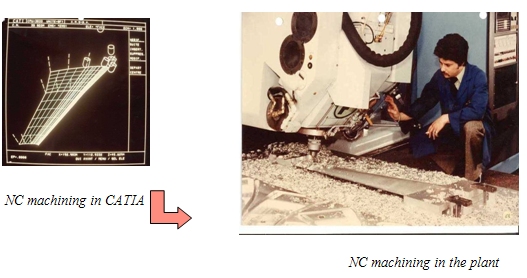
At the end of 1980, the CATIA rumor goes to the very top of the company and Marcel Dassault, the 88 years old mythic founder of the company, ask for a demonstration of the software capabilities. He looks at the design of a surface on the terminal and, after a few minutes, he tells me: “Let me work by myself”. A picture immortalizes this moment: we see the great old engineer Marcel Dassault, Dominique Calmels, my technical manager, and myself on the right. Marcel Dassault understands immediately the value of our software.
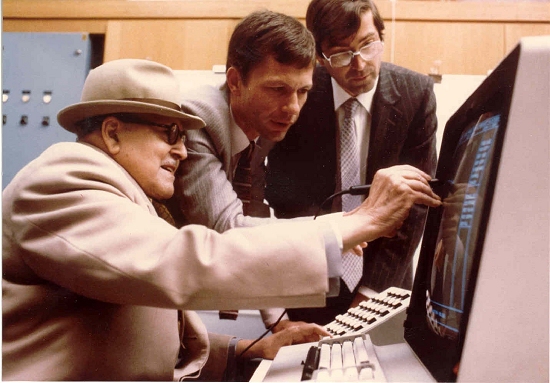
Marcel Dassault, Dominique Calmels, Francis Bernard
The first option is a dead end. As a matter of fact, I have only 15 CATIA developers in my team, at this time, but how could we afford to fund in the future the hundreds developers we would need to address all the necessary functionalities, only for one single company? Obviously, we would have to replace sometime CATIA by a product that we could buy when the CAD/CAM software market is mature enough. Therefore, I plead for the second option: let us create a new company to develop and to sell CATIA worldwide, in all the sectors of the industry. In doing so, we accept the risk that the competitors of Dassault Aviation may also take advantage of CATIA, but also we make it more easy to collaborate with our own partners and suppliers.
This debate between the two options may look somewhat irrational and unnecessary today, the second option being obvious. But it was not the case at this time, and I know several opportunities, including two potential CATIA competitors, which were missed by companies which selected the option one.
DASSAULT SYSTEMES
Early 1981, the decision to diversify into the CAD/CAM technologies and solutions is taken by Dassault Aviation. This is quite exceptional in this enterprise which has kept an SME culture despite its size and its strategic role in the French defense.
We have the technical knowledge and we have the initial Version 0 of CATIA, including 5 integrated products: 3D Shape Design (curves, surfaces, solids), 3D Kinematics , Analysis (surface, volume) , Multi-axis NC machining and a CADAM-CATIA data transfer interface allowing to generate in CADAM a drawing from section curves generated in CATIA. But we have absolutely no knowledge, no experience, and no organization to sell and to support our solution.
We know that the competition will come mainly from USA. Here, there is a huge domestic market in a very dynamic industry, at least ten times more important that our French market. Already a few CAD/CAM vendors are well established, to name the most successful: CADAM (a spin-off of Lockheed Aircraft, with its impressive Drafting product that we use at Dassault Aviation, as a 2D add-on to CATIA), Computer Vision, CALMA (a spin-off of McDonnell Douglas Aircraft), APPLICON,…These vendors have hundreds of employees and hundreds of customers mostly in USA but also in Europe and Asia. And we are only 25 in my team, with only one captive customer, Dassault Aviation. Who knows Dassault, by the way, in the foreign countries, except perhaps in the aerospace community?
Here again, I am lucky to be at the right place, at the right time. Dassault Aviation is one of the biggest French clients of IBM, perhaps the biggest in the scientific and technical domain. In the early 80’s, IBM is by far the worldwide leader in the computer industry, with more than 80% of the market share. It is the great period of the mainframe computers, there is not yet any PC, no Microsoft. Also, IBM has signed in 1977 a worldwide distribution agreement with CADAM Inc. to sell CADAM together with its mainframe computers and graphic terminals. As a matter of fact, CADAM is for IBM an excellent catalyst to generate significant hardware revenue, because the software is running only on the IBM platform.
It happens that I have a good relationship with our IBM salesman, a very dynamic personality. And I propose him a similar deal between IBM and Dassault, where IBM would sell worldwide our software, together with its hardware. The IBM software portfolio would include CADAM for 2D applications and CATIA for 3D applications, with a relatively good level of integration, as long as CATIA includes a CADAM-CATIA data transfer interface.
For Dassault, such deal is mandatory. We cannot go on the market without a sales force, we need a worldwide coverage to compete against the American competition, and we don’t know how to sell and to support a software product. Getting the skills and experience by ourselves and building the appropriate worldwide organization would take too much time to survive. This is a mistake which has been done by our French competitor at that time, called Matra Datavision.
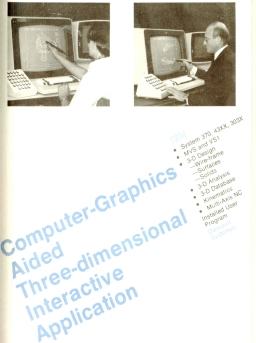 My French IBM friend takes the challenge. At that time, all the IBM decisions are negotiated at the level of its Headquarter in the USA. So, he flies to New York and get in touch with all the IBM executives who may decide. And he does really his job of sales man, this time not to sell a piece of hardware to a customer, but to sell a French software opportunity to the IBM American Company. He succeeds to generate attention, and the IBM executives fly to Paris to negotiate the deal with Dassault. Charles Edelstenne, CFO of Dassault Aviation, leads the negotiation which will end successfully with a worldwide IBM-Dassault agreement signed in July 1981.It is a non-exclusive, 50/50 revenue share agreement where CATIA is sold by IBM as an IBM product. This deal has been extremely successful for both companies; it has been one of the fundamental drivers of the Dassault Systemes success story. And it lasted for nearly 30 years, ending smoothly without any crisis when Dassault Systèmes acquired the IBM Sales force dedicated to its solution at the end of 2009.
My French IBM friend takes the challenge. At that time, all the IBM decisions are negotiated at the level of its Headquarter in the USA. So, he flies to New York and get in touch with all the IBM executives who may decide. And he does really his job of sales man, this time not to sell a piece of hardware to a customer, but to sell a French software opportunity to the IBM American Company. He succeeds to generate attention, and the IBM executives fly to Paris to negotiate the deal with Dassault. Charles Edelstenne, CFO of Dassault Aviation, leads the negotiation which will end successfully with a worldwide IBM-Dassault agreement signed in July 1981.It is a non-exclusive, 50/50 revenue share agreement where CATIA is sold by IBM as an IBM product. This deal has been extremely successful for both companies; it has been one of the fundamental drivers of the Dassault Systemes success story. And it lasted for nearly 30 years, ending smoothly without any crisis when Dassault Systèmes acquired the IBM Sales force dedicated to its solution at the end of 2009.
In 1981, the value of such agreement is not so well perceived. I remember the French authorities asking me why I make an alliance with an American company and some American executives questioning if it is appropriate to make a deal with a semi-communist country…As a matter of fact, there were a few communist Ministers in the French government of that time.
 As for CATIA, we need to give a name to our new company, at this time a subsidiary of Dassault Aviation. It takes just a few days to decide for a name, Dassault Systèmes, and I sketch our first logo.
As for CATIA, we need to give a name to our new company, at this time a subsidiary of Dassault Aviation. It takes just a few days to decide for a name, Dassault Systèmes, and I sketch our first logo.
We launch the company operations in September 1981. I am the President and 20 engineers of my team in Dassault Aviation move with me in Dassault Systèmes. A few people prefer to stay with Dassault Aviation, just because they believe that we engage in a too risky adventure… Charles Edelstenne is the Chairman, a position that he has still today.
Within a few months, my first customers are Honda in Japan, Mercedes and BMW in Germany, SNECMA (now SAFRAN) in France and Grumman Aerospace in USA. It has been a challenge for several reasons:
- The world globalization that we experience today does not exist yet. Our customers in Germany and in Japan don’t speak English, and ourselves we can speak only very poorly…Flying to Japan is an adventure, a 20 hours flight with a stop in Anchorage (Alaska) and no English signs in Tokyo…Even a telephone call between Paris and New York is an event…And of course there is no emails, no Internet. We become unconsciously the actors of globalization.
- The industry is still using massively the 2D drawings as its standard for Design.
- We know well the aircraft industry, but we don’t know anything about the automotive or any other industries.
How did we achieve success? From our experience within Dassault Aviation, we knew that we would face a strong resistance at a time when all the CAD/CAM vendors were selling mostly a 2D CAM/CAM solution. Therefore we decided to escape from selling functions, features, and discussing detailed requirements with our prospects. We decided to sell a complete business transformation, “a revolutionary new way to design and manufacture”.
With such strategy, we escaped from fighting in a battlefield dominated by our strong competitors, when we were still a start-up company. By selling a business transformation, we talked at a higher level of the organization of our customers, most of the time at the CEO and CTO level. And we were perceived more like a partner that a vendor.
Our challenge was to demonstrate very quickly a dramatic innovation, with short term benefits on cycle time and quality, and mid-term benefits on cost. We established a close relationship with the customers to help them implement the business transformation, with major impacts on their way to design and build, instead of implementing only a new tool. And of course, we tried hard to meet all of our commitments on time to generate the confidence in our capabilities to execute.
We also learned fundamental lessons to manage our software development plan:
- A software product should not be specified only by analyzing functions and features with customers or competition analysis. This is a “me too” strategy and the risk is also to develop customers specific products instead of market specific products.
-
Mixing innovation through research and new technologies, with a good understanding of each industry segment processes is the only way to define the specifications of the future successful software products.
In 1986 we had a great success: Boeing made the decision for CATIA. And this success reflects exactly the comments above. As long as I was selling with IBM the functions and features of CATIA, I lost the battle in 1984, 1985. My main competitor was an internally developed product. But when I sold the business transformation, with all its benefits, then I had a meeting with the CEO of Boeing. And he told me: “tell us how we can design an airplane in 3D, this is what we need”. CATIA was only in the background and I used my experience from Dassault Aviation to convince the CEO. Also, frankly speaking, he told me: “I buy CATIA and the relationship with you because you are with IBM”. As a matter of fact Boeing could not implement a huge business transformation without a big name like IBM in the loop. This was one of the values of the partnership with IBM.
The deal with Boeing generated a huge attention in the world. I was invited to speak at the main radio channel in France. And Boeing, a strong competitor of the French Airbus, bought half pages, during one full week, of the most important national newspapers to advertise “Boeing is more French than ever!”
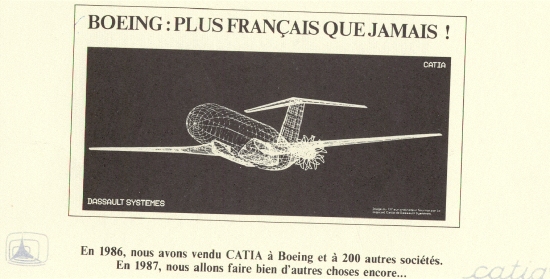 The Boeing advertisement
The Boeing advertisement
In the early 80’s, we had a very poor knowledge of the automotive industry. We did not know enough about their internal processes to sell anything else than function and features in 3D. Hopefully, Honda, Mercedes and BMW had set up an internal team to study the values of 3D and the ways to implement it. Working with these teams, they learned from us the value of 3D and we learned from them the internal processes of Body design, a domain where the automotive industry could use CATIA nearly “as is”. And progressively we created the confidence, they started to deploy CATIA in Body design and we influenced the CATIA development plan to be more competitive in this domain. Later we extended our partnership to address progressively all the automotive processes. The benefits have been incredible, reducing by a factor 10, from 1980 to 2000, the cycle time to produce a new car.
This is the step by step approach that we used to progressively address all the other industries such as Consumer Goods, Machinery, and Shipbuilding. Even IBM became a customer in the mid 80’s and deployed CATIA in its engineering and manufacturing plants.
Progressively, CATIA became the de facto standard in the aerospace industry, and by far the leader in the automotive and the other industries. Since 1995 we are number one in our market.
CATIA evolved not only to handle the functionalities to address all the industry markets, but also to benefit from the new hardware and software platforms : from the mainframes to the UNIX based workstations in the late 80’s, then from the workstations to the PCs with Windows in the late 90’s, and now Internet extends again the potential. Most of our competitors in 1980 disappeared, either because they did not implement the 3D business transformation, such as CADAM that we acquired in 1992, either because they choose to keep their own proprietary hardware platform, like Computer Vision, when the market requested standard platforms.
In 1984, I hire a young engineer, Bernard Charles. He starts to work in the R&D organization to develop the support of the first IBM graphic terminal called IBM 5080 using the colored raster technology to visualize realistically the surfaces and solids. And progressively I promote him to become the R&D manager in 1990. In 1995, according to an agreement with our Chairman, Bernard Charles is taking the position of President, the position he has still today, and I stay in the Executive team, focusing on Market Development in the emerging countries: China, India, South Asia-Pacific, Russia, Africa…
China…I am one of the first IT business man flying to Beijing in 1985, to negotiate the sale of CATIA to the Ministry of Aviation. I remember the old fashioned, dilapidated, and very small airport, the narrow road to go to the only hotel from the 30’s for visitors in Beijing, the “Beijing Hotel” near the Forbidden City. No cars and millions of bicycles. Some people in France were joking about my trip, “what are you doing in this country?...” And now, China is a huge CATIA customer…
We inherited, from the relationship with IBM and with our key customers, a strong culture of partnership. The general idea is to extend and reinforce our strength, in term of functionalities coverage, technologies, customers support, research, or sales, not only with our own resources but with partners. Progressively, we have built an Ecosystem with hundreds partners. Looking at the ecosystem of an enterprise is, for me, a key parameter to measure its strength or its weakness. We have made also more than 15 company acquisitions to accelerate our solution coverage. So the very small start-up with 20 people in 1981 is now a large group with more than 8000 employees, and an organization with development laboratories as well as services and sales subsidiaries in many countries.
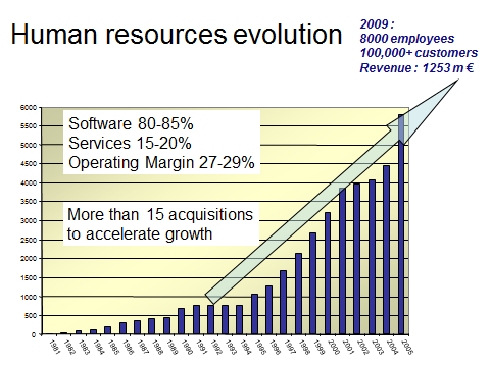
CAD/CAM became too restrictive to identify the Dassault Systèmes solution; it has been replaced in the early 2000’s by PLM, the acronym for Product Life Cycle Management. And new Brand names have been added to CATIA to address the full PLM: DELMIA to support the manufacturing plant, ENOVIA to support the collaboration internally and with the extended enterprise of our customers, SIMULIA for Analysis and Simulation, SolidWorks for 3D modeling, and 3DVIA for 3D visualization.
I retired from Dassault Systèmes in 2006…How could I conclude this paper? Well, perhaps I may conclude in saying that the success of Dassault Systèmes is the combination of several fundamentals which have been drafted above:
- Being at the right place at the right time : IT revolution, globalization, Dassault
- Inventing a business transformation with a long term vision : “3D for all”
- Making the right strategic decisions : Dassault Systèmes creation, IBM partnership, Product management, Ecosystem implementation, Customers partnerships, well positioned acquisitions
- A strong management and execution process.
See also:
Permanent link :: http://isicad.net/articles.php?article_num=14120

|
 |